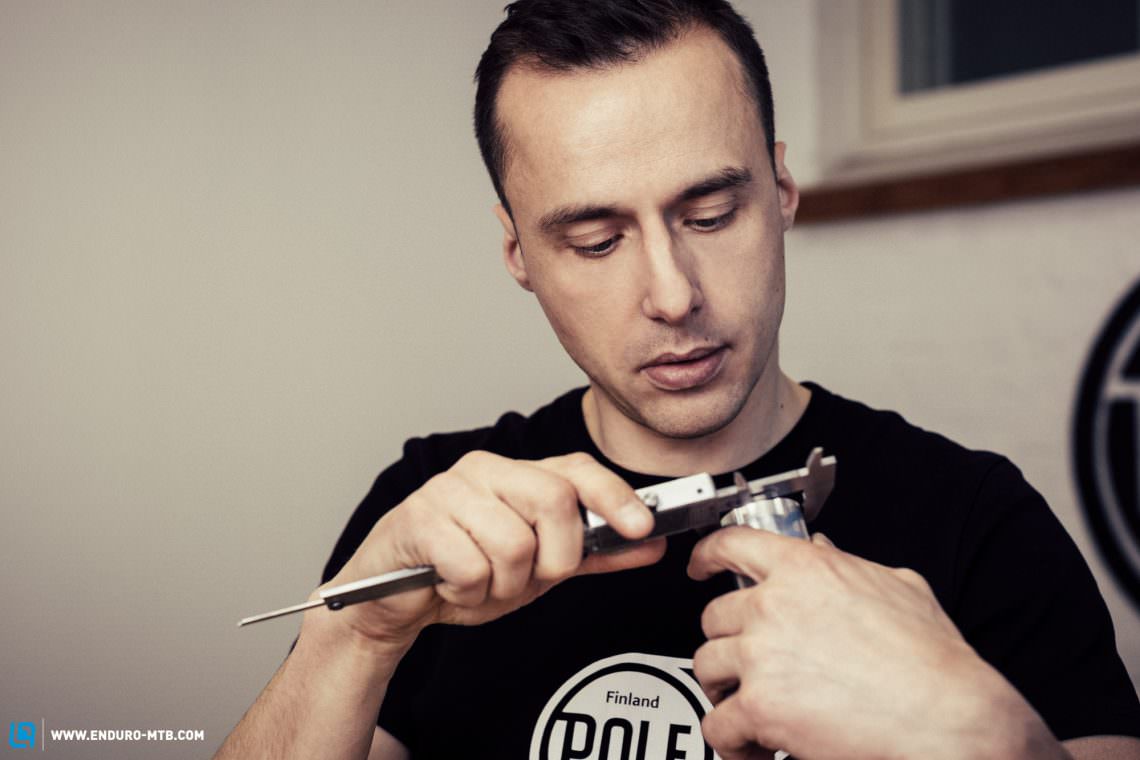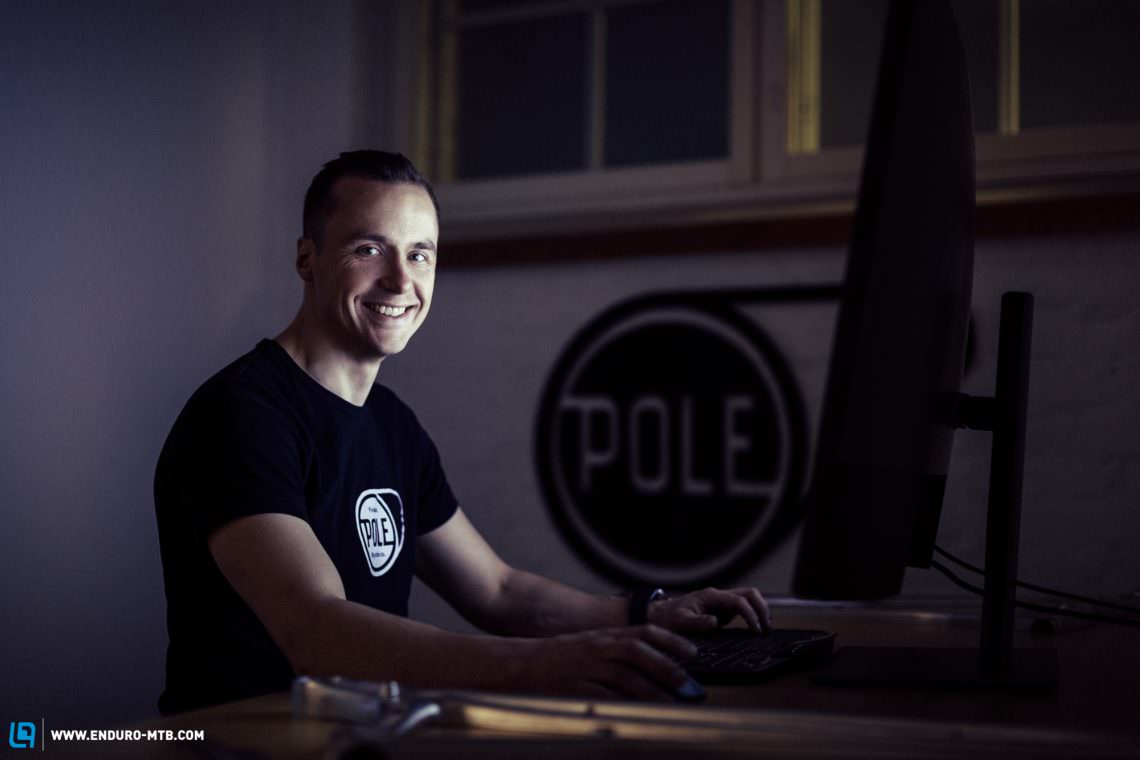With his latest CNC machined bike, the man behind the radical brand Pole is not only asking us to rethink the use of aluminium, but also heralding a more sustainable industry. Is he a heretic, an environmentalist, an inventor, a visionary or simply a mad-man? Who is Leo Kokkonen?
The minute you meet Leo Kokkonen, CEO of Pole Bicycles, you know he is a man of strong character. Born into a family of inventors, Leo is fierce in his opinions and values, clearly gifted – or maybe cursed – with a highly analytical mind. With a passion that borders on obsessive, when Leo talks it’s clear that he delves deep into any topic that interests him, questioning everything, analysing then subconsciously deconstructing before reimagining with an improved concept. This is a process that happens continuously, whether he is looking at the cable routing of his latest creation or the design of an office chair he finds himself sitting on. With a desire to solve problems and an unrelenting vision it was clear that Leo’s unconventional approach would never flourish within the constraints and red-tape of a big bike brand, so he founded his own mountain bike company, Pole Cycles was born.

Pole Cycles were not the first company to push a radical geometry concept, but they were arguably the first to take it successfully to the mainstream, pushing the ‘long and slack’ as not just a hardcore racers trail destroyer, but a do-it-all bike for every level. In just two years the small and relatively unknown brand went viral and started everyone worrying that the bike they were riding was too small. Their bike was fast too! The Pole Evolink quickly gained an almost cultish following, the frames sold out and fan groups sprang up on Facebook. The Evolink story has already been well told, but when sneak peeks of Pole’s latest bike started to leak from Pole’s social feeds, swooping and sculpted, the jungle drums started drumming. Was it carbon? No, it was clearly metal. But, without welds what the hell was it?
We cannot have a great business without trying something new, we can never compete with Trek or Canyon on price and volumes, we simply do not have that much money.

The truth was outed, it was the new Pole Machine, Leo’s latest creation. A 160 mm 29er enduro bike machined like two sides of a clamshell from huge billets of aluminium before being bonded together. In a market where differences between brands may often be no more than just colours, it was a thunderclap to the industry. It was surely impossible, such a process would be prohibitively expensive, prohibitively time consuming and prohibitively untested – or else why had nobody done it before? Leo disagreed, and the bike is built and being ridden hard. Leo openly admits that the machined concept was never a ‘lightbulb moment’, instead it was born out of frustration that a carbon fibre project could not be found that met his moral standards. “When I was in China with our 3D printed prototype I got sad there, realizing that when it comes to efficiency, productivity and waste management the process of carbon manufacturing is not sustainable. Cycling is a hobby, we are grown up people who play with bikes, we don’t need them, so should we not pay a little bit extra if we know that by doing so we will cause less harm to our surroundings” After returning from China, Leo was depressed with the project, having had high hopes for carbon, and needed inspiration.

I like to think that I am a smart guy. I don’t come from a bike design background, I come from industrial design and I know that even though carbon sounds high-tech, it does not look like a proper industry, it looks like old-fashioned technology, handmade. I knew there was a better way.
Inspiration unexpectedly came from a Finnish tractor factory. During a tour within the factory walls, Leo observed no handcrafting, everything was automated, using high-tech technology to improve the quality and efficiency of every process. Was there a solution here? Research began, first Leo thought about welding, then he thought of pressing the bike together from two halves of sheet metals, each time reaching out to people and universities who were experts in their field. Then, during a chance conversation in a factory, The Machine concept was born. “Why don’t you machine some parts of it then use bonding?” was the question that got Leo thinking, the seed was sown and Leo fixed his focus onto how far he could take it. Could he machine the whole thing? Drawing input from colleagues in the aerospace industry the Machine concept gained momentum and everything started clicking.
A prototype was built and it is without-a-doubt my most expensive bike. Nobody has a bike as expensive as this. People think 10k is expensive, fuck that. This first one is really, really expensive!
So, born from one crazy idea, Leo started believing in the CNC machining and was hooked. But at what cost? The price of CNC machining is really high, it takes time and investment to carve shapes from 7075 aluminium. Solutions need to be found. The time needed to machine his bike is a closely guarded secret, but time is money so Leo started studying new 3D programs in order to make the frame more CNC friendly, optimise the design and control the wall thicknesses. When questioned why the industry has not looked at this kind of technology Leo is clear in his beliefs. “It’s not easy to get into the bike industry, it’s easier if you are making parts, but to make bikes is so much tougher, the investment is really high. I perhaps think a little differently to many people, I have strong values and opinions about how I want things to be.”

Cynics may say that playing the ‘environmentalist card’ on Poles recent viral ‘why we won’t build a carbon bike’ story was nothing more than clever marketing, but Leo is quick to voice his opinion. “We don’t want to do any unnecessary harm, as humans all we do is consume nature. When we set up a company we wrote down a business plan, a concept of how we should work, and even after all this time it has not changed a bit. The business plan was not a list of tasks, but more a collection of aims, and one of those aims was simply ‘to create the best bike in the world’. The best bike means it’s fast, it’s durable and importantly it’s ethical. We can say that the Machined frame is fast, it is durable and it’s even more ethical.”
Look at Tesla, their success and moral values are higher than General Motors, but yet they produce a fraction of the volume of General Motors.
In business, like Icarus, sometimes companies can fly too high too soon, and Pole faced a struggle for finance. “The problem we come to is we have sold all of our bikes, always. This means as we grow, we need more money. The lead-time from Taiwan is half a year from when we say go, and before we can do that we need money, so the return on any investment is relatively slow. A lot of investors don’t like being in the bike industry as there are ways of making money faster in other industries. One sector we know is big is the high-end bike industry. I could not see myself designing an OK bike, my passion is not there. The people who make their business making generic sports bikes just go to Taipei and point at what they want. At Pole, we just want to make the best product.”

Leo’s new Machine bike is not only an innovation in terms of design, but also challenges the very foundation of how the industry works. For most large brands, every year numbers are crunched and large orders of frames are placed. The quantities of these orders is a gamble of meeting demand without too much overstock and the capital investment is huge. Pole intends to produce the Machine frame on demand, no stock will be held, you simply order a bike and the CNC machines start to cut. This is a dream situation for a brand and its sales agents. Not only would this reduce costs, but it would also avoid the wholesale reductions of overstock bikes at the end of each model year, a process that damages the businesses of smaller bike shops.
We are in the future with this. A lot of people say why don’t you just print the bikes? If printing bikes was profitable, nobody would weld bikes anymore, nobody would make carbon fibre bikes. There would be no reason if you could just print them.
Environmentalist, humanist or simply a focussed mind, it’s hard to argue with Leo’s values and conviction. “I think that we should strive for better, we should invent stuff, we have brains and can create amazing things. I enjoy looking at well-thought-out products and seeing how innovative people can be. At Pole, we like to keep things dynamic, if someone gets an idea, why wait one year when we can do it next week? If we find a problem with a Machine frame we can just solve it on the next batch, it’s like software, 1.1, 1.2 etc, whenever someone buys one of our bikes they know they are on the most up to date version. You can be sure that you are on the latest design with the most up to date innovation – surely that’s how it should be.”

Whether the Pole Machine will deliver on the trails, or indeed be the best product is still to be seen, but it is unquestionably the most innovative bike of its generation. As you read this, Pole Machine frames are currently emerging from vast CNC machines, and we hope to bring you a review very soon.
This article is from ENDURO issue #032
ENDURO Mountainbike Magazine is published in a digital app format in both English and German. Download the app for iOS or Android to read all articles on your tablet or smartphone. 100% free!

Did you enjoy this article? If so, we would be stoked if you decide to support us with a monthly contribution. By becoming a supporter of ENDURO, you will help secure a sustainable future for high-quality mountain bike journalism. Click here to learn more.
Words: Photos: Toni Rutanen











